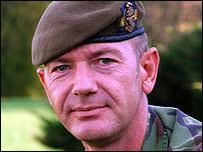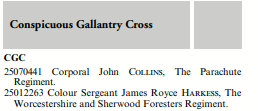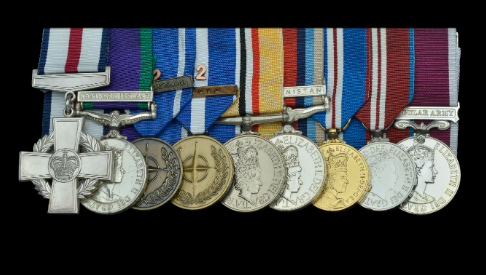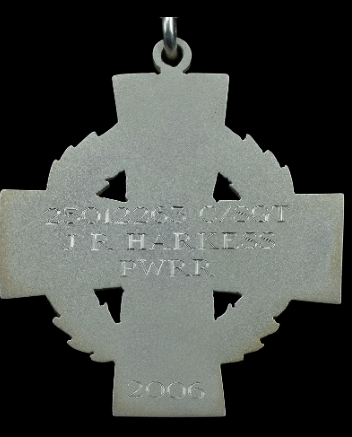b. 1968 Mansfield, Nottinghamshire.
DATE OF CGC ACTION: 23/05/2006. 11/06/2006 and 30/07/2006 Al Amarah, Iraq.
James was born in Mansfield, Nottinghamshire in 1968, and after leaving school became a miner at Clipstone Colliery. James became disillusioned as a miner, and chose to enlist in the British Army. He enlisted with the Prince of Wales’ Royal Regiment in 1992. He served in Northern Ireland and in former Yugoslavia (particularly Kosovo) before in 2006 was posted to Iraq. He would show repeated gallantry during intense urban warfare against the Mahdi Army militia in Al-Amarah. He held the rank of Colour Sergeant at the time.
On the first occasion in May 2006 50 heavily-armed militiamen tried to cut off part of his company. Recognizing the danger, he secured a route to safety leading his platoon from his Warrior infantry fighting vehicle whilst under heavy fire. The citation for his CGC reads: “Having gained the tactical advantage, he then held the vital ground he had won which allowed the company to be extracted safely. His actions prevented the isolation of British soldiers, denied the enemy the opportunity to close and saved lives”.
Weeks later he played a crucial part in a search operation in Al Amarah that led to the biggest and most intense battle in Iraq for two years. The citation reads: “The narrow alleyways and roof tops provided cover for 200 Mahdi Army soldiers as they engaged C Company with rocket propelled grenades, heavy small arms fire, snipers, blast bombs and grenades. Colour Sergeant Harkess quickly secured a key junction, a pivotal position he held for six hours….Strike marks peppered his vehicle yet he refused to take cover.”
Finally in July 2006 Harkess took part in an operation to protect a re-supply convoy that resulted in an insurgent ambush. “Despite enemy fire, he accepted that he could not withdraw his platoon without exposing the convoy to greater danger,” says the citation. “With complete disregard to his personal safety, he again repeatedly exposed himself to danger in order to locate the enemy.” The citation concludes that “throughout these engagements Colour Sergeant Harkess was steadfast under extreme pressure and led his platoon in the face of the enemy with raw bravery”.
Harkess was later promoted to Sergeant-Major and retired from the Army in 2014 after 22 years service. Due to being unable to work due to the physical injuries from his Army career, James made the difficult decision to sell his medal group in 2015. They were sold for a hammer price of £130,000 on 25 February 2015. When asked about the sale, James replied “I loved the Army. I have always said that if I was able to do it all over again then I would. I miss it but you realise that when it’s your time to leave then you have to go.” Asked why he has decided to sell his medals, he explains: “I have got to the stage when I have all the memories that I require. They should raise a substantial amount of money and I suffer from ill-health which has meant that I have not been able to work since I left the Army. Because of this I am dependent on my Army pension so the sale will help me financially.”
James, who has been married twice, when interviewed for the Dan Collins book “In Foreign Fields” was modest about his CGC action – “It was noisy, obviously, and at various times I had to get out of the turret and stand on the vehicle to shout at the lads on the ground, to either reassure them or direct them. In my citation for the medal, it talks about this being evidence of ‘immense courage’ but to be honest anyone would have done exactly the same, and they probably have at various times. It wasn’t as though we even had time to be nervous or scared. It was so intense……you just don’t have time to think about anything else.”
CGC CITATION:
Colour Sergeant Harkess is a Platoon Warrior Sergeant in C Company, The 1st Battalion The Princess of Wales’s Royal Regiment, deployed with The Queen’s Royal Hussars Battlegroup in Al Amarah, Southern Iraq on Operation TELIC VIII.
On 23 May 2006 Colour Sergeant Harkess’s platoon were tasked to support another platoon in an operation in a Mahdi Army stronghold. They were under attack from more than 50 heavily-armed Militia. Instinctively, Colour Sergeant Harkess moved to secure the extraction route for the troops now under sustained, accurate and lethal enemy fire. Colour Sergeant Harkess’s platoon then came under fire themselves from small arms and rocket propelled grenades from several directions. Colour Sergeant Harkess attacked in his Warrior, leading his platoon from the front under heavy enemy fire. He then held the vital ground despite immense and prolonged pressure from the rapidly reinforcing enemy. The Company safely extracted. His quick action almost certainly saved lives.
Colour Sergeant Harkess’s platoon formed part of the C Company Group for a search operation in Al Amarah, on 11 June 2006. The ensuing six hour battle was the largest and most intense in Iraq since 2004. The enemy of over 200 Mahdi Army soldiers attacked constantly, making use of narrow alleyways and roof tops to engage the group with Rocket Propelled Grenades and small arms fire, including sniper, blast bombs and grenades. The enemy was well supplied and had significant reserves. Again, Colour Sergeant Harkess moved himself to a critical position where he remained under fire for the entire six hours. With significant communications problems, he exposed himself to great personal danger to command his men, leading from his open Warrior, conducting repeated counter attacks and surges. He engaged roof-top gunmen with his rifle, whilst simultaneously commanding his gunner onto ground targets. He demonstrated huge courage throughout to ensure the enemy was kept at bay.
On 30 July 2006 C Company were deployed in support of a re-supply convoy of potentially strategic importance. Colour Sergeant Harkess was now the Platoon Commander. As the convoy approached the town of Al Maymunah, Colour Sergeant Harkess’s men came under sustained fire from organised Mahdi Army ambush teams. For over an hour Colour Sergeant Harkess led his platoon under heavy enemy fire from every direction. For Colour Sergeant Harkess there was no option of withdrawal. He repeatedly exposed himself to enemy fire in order to gain situational awareness and to command and control the battle and retain the initiative. While commanding the platoon he continued to deliver effective fire to enemy positions, killing or forcing them to withdraw both with his rifle and his vehicle. His position was critical to the company commander and he was steadfast under extreme pressure, which included accurate sniper fire. His gallantry and leadership were critical in ensuring that the convoy got through.
On these three occasions Colour Sergeant Harkess’s decisive and courageous actions in hostile circumstances have saved life. He has been an outstanding example to his men. His gallantry and composure under fire, coupled with his calm leadership in the face of a determined enemy, repeatedly demonstrated, deserve the highest public recognition.
LOCATION OF MEDAL: PRIVATELY HELD.




